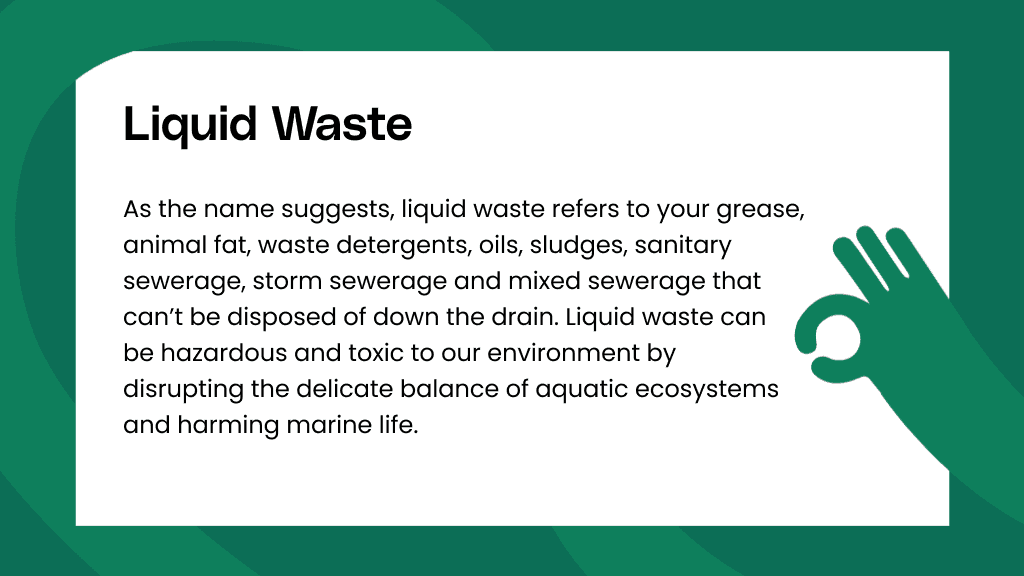Some Known Incorrect Statements About Reclaim Waste
Some Known Incorrect Statements About Reclaim Waste
Blog Article
The Best Strategy To Use For Reclaim Waste
Table of ContentsSee This Report on Reclaim WasteReclaim Waste for BeginnersThe Ultimate Guide To Reclaim WasteGetting The Reclaim Waste To WorkThe Definitive Guide to Reclaim Waste
Check out the kinds, occurrences, and kinds of fluid waste. Domestic sewer waste describes the waste and products from a residential sewage-disposal tank. This sort of waste is created by people in houses, colleges, and other structures. This only includes septic systems that have a drain field. The appropriate administration and disposal of residential sewer waste require fluid waste to be moved to a sewage therapy plant where the proper approaches and devices are applied to detoxify and dispose of waste.
Industrial waste frequently consists of potential dangers, such as combustible materials or a blend of fluid and strong waste products, and requires an advanced and comprehensive disposal procedure. The disposal of business waste typically includes the filtering of waste prior to transport to ensure safe and appropriate disposal. Hazardous waste is developed from byproducts and runoff of industrial processes and manufacturing.
This sort of waste can not make use of the same sewer management transportation or procedures as septic or business fluids. The industrial waste administration procedure calls for the inspection and screening of liquid waste before it goes through the disposal process (liquid waste disposal). Runoff waste is the liquid waste that comes from runoff and excess stormwater in highly populated locations or cities
Runoff waste can create contamination and flooding if not taken care of effectively. Making sure appropriate waste management can protect against calamities and decrease ecological damage.
What Does Reclaim Waste Do?
Call PROS Solutions today to discover our waste management and disposal solutions and the proper methods to care for the fluid waste you generate.
(https://reclaimwaste1.blog.ss-blog.jp/2024-11-12?1731425991)Do you understand what happens to your water when you draw the plug, purge the bathroom or drain the washing machine? No? Well, it's worth knowing. This supposed 'wastewater' is not only a vital source but, after therapy, will be launched to our land, waterways or the ocean. Made use of water from toilets, showers, bathrooms, kitchen sinks, washings and industrial procedures is known as wastewater.

water utilized to cool equipment or clean plant and devices). Stormwater, a form of wastewater, is drainage that moves from agricultural and city areas such as roof coverings, parks, gardens, roadways, paths and seamless gutters into stormwater drains, after rainfall. Stormwater flows unattended directly to regional creeks or rivers, at some point reaching the ocean.
How Reclaim Waste can Save You Time, Stress, and Money.
In Queensland, many wastewater is dealt with at sewer treatment plants. Wastewater is carried from residential or commercial websites via a system of sewage systems and pump terminals, known as sewerage reticulation, to a sewage treatment plant. City governments develop, preserve and operate most sewage treatment plants. Operators are licensed under the Environmental Security Act 1994 to discharge treated wastewater at an acceptable environmental standard right into rivers.
The check Department of Natural Resources recommends city governments concerning handling, operating and preserving sewerage systems and therapy plants. In unsewered locations, city governments may call for owners to set up private or home sewage therapy systems to deal with domestic wastewater from bathrooms, kitchens, bathrooms and washings. The Division of Natural Resources authorises the use of house systems when they are verified to be efficient.
In some brand-new communities, treatment of some stormwater to get rid of trash, sand and crushed rock has started using gross toxin traps. Wastewater therapy occurs in four phases: Removes strong matter.
Wastewater after that flows right into huge tanks where solids resolve and are removed as sludge. Oil and residue are skimmed from the surface. Makes use of little living microorganisms understands as micro-organisms to damage down and remove continuing to be dissolved wastes and fine fragments. Micro-organisms and wastes are incorporated in the sludge. Eliminates nitrogen and phosphorus nutrients that could trigger algal flowers in our waterways and threaten marine life.
The smart Trick of Reclaim Waste That Nobody is Discussing
Nutrient elimination is not available at all sewage treatment plants since it calls for expensive specialised tools. Clear fluid effluent produced after treatment may still consist of disease-causing micro-organisms - liquid waste disposal.

A lot of wastewater flows right into the sewerage system. Under the Act, local governments provide authorizations and permits for environmentally appropriate tasks (Periods) including wastewater launches that could have a regional influence.
Examine This Report about Reclaim Waste
Otherwise, examples are considered laboratory analysis. Often lots of examinations are needed to develop the degrees of each of the various pollutants such as oils, heavy metals and pesticides in water. Tracking gives valid information about water high quality and can verify that permit problems are being fulfilled. The information obtained through monitoring offers the basis for making water top quality choices.
Report this page